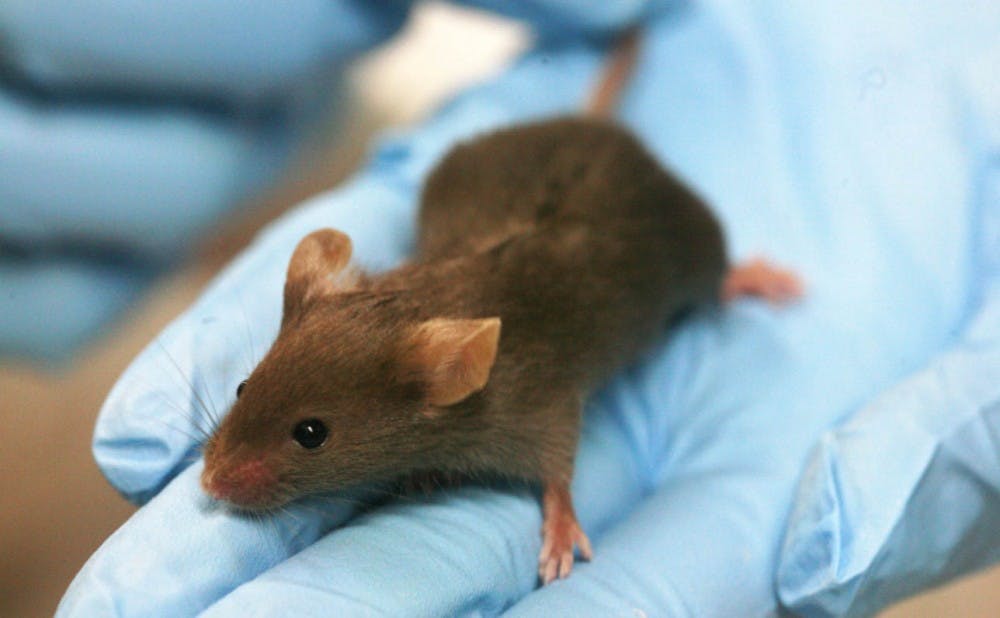The gene-editing tool CRISPR has recently been in the limelight for its ability to precisely target and cut out specific DNA sequences. Now, Duke researchers have taken the next step by showing how the technology can be used in living animals.
Duke researchers used a modified version of the CRISPR-Cas9 system to suppress a mouse cholesterol-regulating gene in a study published in the journal Nature Communications April 26. Since previous research used the technology to target the DNA of cells in culture—as opposed to living organisms—the discovery marks an advancement toward utilizing CRISPR as a therapeutic treatment.
“This demonstrates that you can use these types of CRISPR tools not just for changing DNA sequence, but [also] for applications where you can pick any gene in the genome and go in and turn that gene on or off without modifying DNA,” said Charles Gersbach, Rooney Family associate professor of biomedical engineering and senior author of the paper.
The traditional CRISPR system includes a protein called Cas9 bound to a strand of RNA—known as guide RNA—that recognizes a specific sequence of DNA, according to the paper. When the guide RNA encounters that DNA, the CRIPSR complex binds to the DNA, and Cas9 acts like a pair of scissors to cut out the targeted section of the genome.
Researchers have been trying to harness this system to excise DNA mutations known to cause certain rare diseases, Gersbach noted.
However, he added, treating more common diseases requires adjusting gene expression levels by turning certain genes on or off, as opposed to cutting them out of the genome entirely.
For this paper, Gersbach's lab used a modified version of CRISPR in which the Cas9 protein had lost its ability to cut DNA, but was able to attract other molecules in the cell to keep the targeted gene turned off. In this instance, the gene was Pcsk9, which is involved in regulating cholesterol.
“[Pcsk9 has] been a popular drug target because if you block it, you can lower cholesterol levels, and that can be useful in treating cardiovascular disease,” Gersbach said.
Pratiksha Thakore, lead author of the paper and a former graduate student in Gersbach’s lab, added that they also chose the gene because its activity can be easily measured.
“Practically speaking, an important question when using these CRISPR-Cas9 repressors is what happens over time to the silencing,” she said. “Because PCSK9 [the product of the Pcsk9 gene] is secreted into the blood, it was a very good model gene for us to use because we could take blood samples from the mice in the study and track what was happening to the Pcsk9 expression.”
But, before they could test CRISPR’s ability to silence the gene, the researchers had to choose a vehicle that could safely and efficiently deliver the treatment to the liver cells of mice.
To do this, they turned to adeno-associated viruses, which have been studied extensively in gene therapy, Thakore explained. The AAVs act as cocoons that house the CRISPR machinery and shuttle it throughout the body before depositing the gene editing technology inside a specific type of cell.
She noted that AAVs are a safe method of delivery since they have already been approved for gene therapy use in Europe and are in late-stage clinical trials in the United States. Nonetheless, adapting CRISPR to fit inside the cramped interior of an AAV proved to be a challenge.
“The CRISPR-Cas9 system that’s most widely used wasn’t easily delivered using the AAV system, so we had to explore the use of other CRISPR-Cas9s,” Thakore said.
Because the CRISPR-Cas9 system is adapted from bacteria, researchers chose a smaller variant of the protein that was found inside a different strain of bacteria, she explained. The smaller Cas9 protein could now successfully squeeze inside the AAV.
Gersbach emphasized the longevity of this treatment, noting that Pcsk9 was repressed for six months with just one administration of the therapy. If properly developed and tested, CRISPR delivery could be a more cost-effective option than current treatments, which must be given more frequently, he added.
The mice in the experiment did show an immune response to the CRISPR delivery, Gersbach noted, but it was not severe.
“The transient immune response kind of dissipated over time without any intervention,” he said. “While we did observe an immune response, there weren’t any kind of adverse consequences.”
Moving forward, Thakore indicated that it would be important to examine the immune response further and determine potential methods for mitigating the response.
Testing the AAV-based delivery system in larger animals and evaluating its safety, Gersbach added, would be an important step in determining whether the system would be viable for clinical use in the future.
Get The Chronicle straight to your inbox
Sign up for our weekly newsletter. Cancel at any time.
He said that he was also looking forward to targeting different types of tissues with the CRISPR system. After all, he noted, delivering the therapy to liver cells by injecting AAVs into the bloodstream is fairly straightforward because of the liver’s job to filter blood. Other body tissues, such as skeletal muscle, might be more difficult to target, Gersbach explained.
Another potential experiment, he added, could focus on studying diseases where the targeted gene needs to be turned on as opposed to off.
“The ability to go in and change the expression of any gene and not just [change] a DNA mutation opens up the door to much more common diseases like cardiovascular disease, as we demonstrated here,” Gersbach said.

